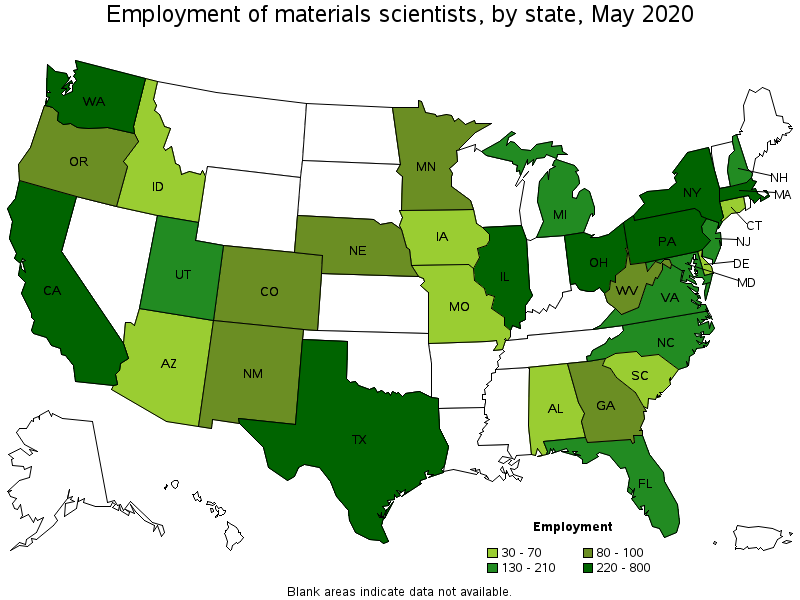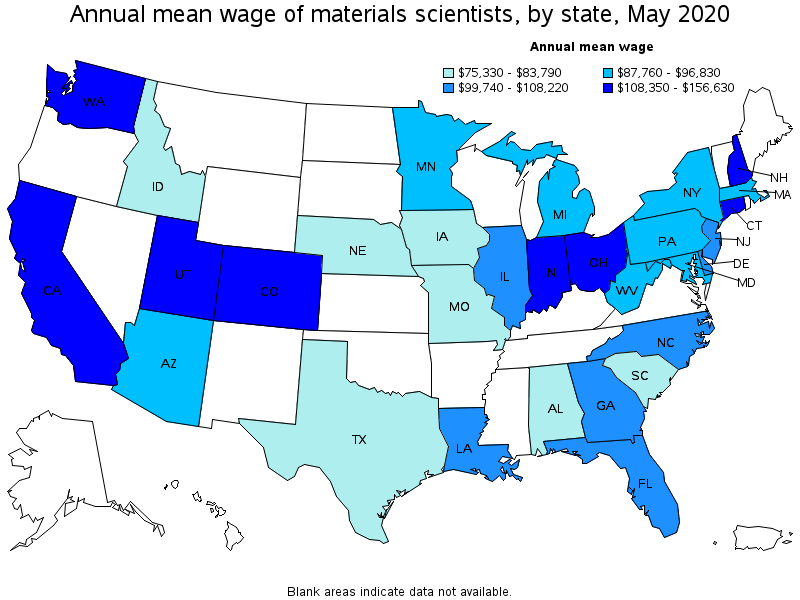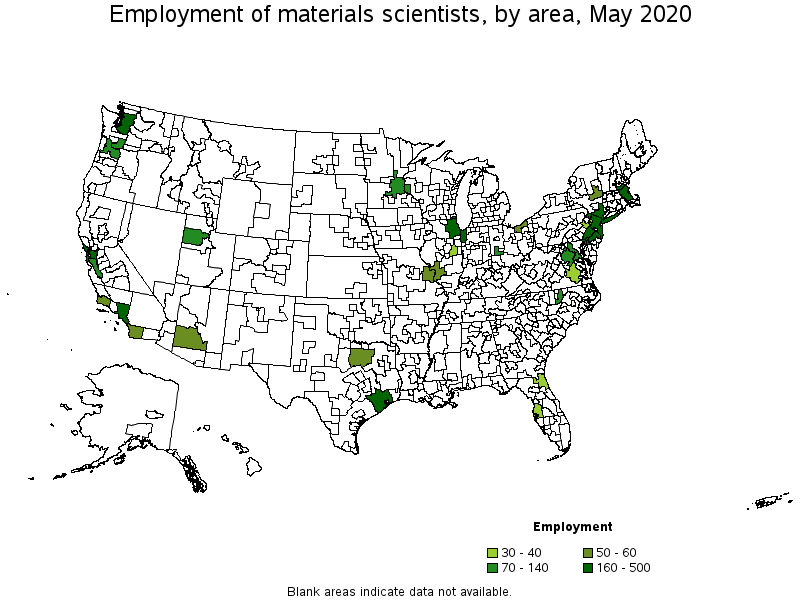An official website of the United States government
 United States Department of Labor
United States Department of Labor
Research and study the structures and chemical properties of various natural and synthetic or composite materials, including metals, alloys, rubber, ceramics, semiconductors, polymers, and glass. Determine ways to strengthen or combine materials or develop new materials with new or specific properties for use in a variety of products and applications. Includes glass scientists, ceramic scientists, metallurgical scientists, and polymer scientists.
Employment estimate and mean wage estimates for Materials Scientists:
| Employment (1) | Employment RSE (3) |
Mean hourly wage |
Mean annual wage (2) |
Wage RSE (3) |
|---|---|---|---|---|
| 6,930 | 7.0 % | $ 50.21 | $ 104,450 | 1.7 % |
Percentile wage estimates for Materials Scientists:
| Percentile | 10% | 25% | 50% (Median) |
75% | 90% |
|---|---|---|---|---|---|
| Hourly Wage | $ 26.35 | $ 35.16 | $ 47.82 | $ 62.93 | $ 79.47 |
| Annual Wage (2) | $ 54,810 | $ 73,130 | $ 99,460 | $ 130,890 | $ 165,290 |
Industries with the highest published employment and wages for Materials Scientists are provided. For a list of all industries with employment in Materials Scientists, see the Create Customized Tables function.
Industries with the highest levels of employment in Materials Scientists:
| Industry | Employment (1) | Percent of industry employment | Hourly mean wage | Annual mean wage (2) |
|---|---|---|---|---|
| Scientific Research and Development Services | 1,770 | 0.23 | $ 52.32 | $ 108,830 |
| Management of Companies and Enterprises | 1,040 | 0.04 | $ 57.80 | $ 120,230 |
| Chemical Manufacturing (3251, 3252, 3253, and 3259 only) | 680 | 0.19 | $ 44.21 | $ 91,970 |
| Architectural, Engineering, and Related Services | 510 | 0.03 | $ 43.49 | $ 90,460 |
| Colleges, Universities, and Professional Schools | 460 | 0.02 | $ 34.11 | $ 70,950 |
Industries with the highest concentration of employment in Materials Scientists:
| Industry | Employment (1) | Percent of industry employment | Hourly mean wage | Annual mean wage (2) |
|---|---|---|---|---|
| Scientific Research and Development Services | 1,770 | 0.23 | $ 52.32 | $ 108,830 |
| Chemical Manufacturing (3251, 3252, 3253, and 3259 only) | 680 | 0.19 | $ 44.21 | $ 91,970 |
| Pharmaceutical and Medicine Manufacturing | 320 | 0.11 | $ 46.06 | $ 95,800 |
| Semiconductor and Other Electronic Component Manufacturing | 360 | 0.10 | $ 57.86 | $ 120,340 |
| Navigational, Measuring, Electromedical, and Control Instruments Manufacturing | 310 | 0.07 | $ 60.76 | $ 126,380 |
Top paying industries for Materials Scientists:
| Industry | Employment (1) | Percent of industry employment | Hourly mean wage | Annual mean wage (2) |
|---|---|---|---|---|
| Navigational, Measuring, Electromedical, and Control Instruments Manufacturing | 310 | 0.07 | $ 60.76 | $ 126,380 |
| Management, Scientific, and Technical Consulting Services | 70 | (7) | $ 58.26 | $ 121,180 |
| Semiconductor and Other Electronic Component Manufacturing | 360 | 0.10 | $ 57.86 | $ 120,340 |
| Management of Companies and Enterprises | 1,040 | 0.04 | $ 57.80 | $ 120,230 |
| Medical Equipment and Supplies Manufacturing | 120 | 0.04 | $ 53.04 | $ 110,330 |
States and areas with the highest published employment, location quotients, and wages for Materials Scientists are provided. For a list of all areas with employment in Materials Scientists, see the Create Customized Tables function.

States with the highest employment level in Materials Scientists:
| State | Employment (1) | Employment per thousand jobs | Location quotient (9) | Hourly mean wage | Annual mean wage (2) |
|---|---|---|---|---|---|
| California | 800 | 0.05 | 0.98 | $ 54.73 | $ 113,840 |
| Massachusetts | 470 | 0.14 | 2.82 | $ 44.38 | $ 92,300 |
| Texas | 400 | 0.03 | 0.66 | $ 37.95 | $ 78,940 |
| Washington | 380 | 0.12 | 2.41 | $ 56.17 | $ 116,840 |
| Ohio | 330 | 0.06 | 1.30 | $ 54.56 | $ 113,490 |

States with the highest concentration of jobs and location quotients in Materials Scientists:
| State | Employment (1) | Employment per thousand jobs | Location quotient (9) | Hourly mean wage | Annual mean wage (2) |
|---|---|---|---|---|---|
| New Hampshire | 130 | 0.20 | 4.07 | $ 75.31 | $ 156,630 |
| Delaware | 60 | 0.15 | 2.92 | $ 48.57 | $ 101,030 |
| Massachusetts | 470 | 0.14 | 2.82 | $ 44.38 | $ 92,300 |
| West Virginia | 90 | 0.14 | 2.74 | $ 43.43 | $ 90,330 |
| Utah | 190 | 0.13 | 2.62 | $ 52.09 | $ 108,350 |

Top paying states for Materials Scientists:
| State | Employment (1) | Employment per thousand jobs | Location quotient (9) | Hourly mean wage | Annual mean wage (2) |
|---|---|---|---|---|---|
| New Hampshire | 130 | 0.20 | 4.07 | $ 75.31 | $ 156,630 |
| Connecticut | 30 | 0.02 | 0.41 | $ 66.05 | $ 137,380 |
| Indiana | (8) | (8) | (8) | $ 59.04 | $ 122,810 |
| Colorado | 100 | 0.04 | 0.77 | $ 57.82 | $ 120,270 |
| Washington | 380 | 0.12 | 2.41 | $ 56.17 | $ 116,840 |

Metropolitan areas with the highest employment level in Materials Scientists:
| Metropolitan area | Employment (1) | Employment per thousand jobs | Location quotient (9) | Hourly mean wage | Annual mean wage (2) |
|---|---|---|---|---|---|
| Boston-Cambridge-Nashua, MA-NH | 500 | 0.19 | 3.88 | $ 50.79 | $ 105,640 |
| New York-Newark-Jersey City, NY-NJ-PA | 260 | 0.03 | 0.59 | $ 50.89 | $ 105,860 |
| San Francisco-Oakland-Hayward, CA | 210 | 0.09 | 1.80 | $ 52.17 | $ 108,510 |
| Philadelphia-Camden-Wilmington, PA-NJ-DE-MD | 200 | 0.08 | 1.52 | $ 47.68 | $ 99,170 |
| Los Angeles-Long Beach-Anaheim, CA | 190 | 0.03 | 0.64 | $ 52.93 | $ 110,100 |
| Chicago-Naperville-Elgin, IL-IN-WI | 180 | 0.04 | 0.84 | $ 51.48 | $ 107,070 |
| Seattle-Tacoma-Bellevue, WA | 160 | 0.08 | 1.67 | $ 53.46 | $ 111,190 |
| Houston-The Woodlands-Sugar Land, TX | 160 | 0.05 | 1.08 | $ 44.82 | $ 93,220 |
| San Jose-Sunnyvale-Santa Clara, CA | 140 | 0.12 | 2.49 | $ 59.85 | $ 124,480 |
| Washington-Arlington-Alexandria, DC-VA-MD-WV | 100 | 0.03 | 0.67 | $ 40.51 | $ 84,270 |

Metropolitan areas with the highest concentration of jobs and location quotients in Materials Scientists:
| Metropolitan area | Employment (1) | Employment per thousand jobs | Location quotient (9) | Hourly mean wage | Annual mean wage (2) |
|---|---|---|---|---|---|
| Champaign-Urbana, IL | 30 | 0.32 | 6.40 | (8) | (8) |
| Santa Maria-Santa Barbara, CA | 50 | 0.29 | 5.78 | $ 50.69 | $ 105,440 |
| Durham-Chapel Hill, NC | 70 | 0.24 | 4.78 | $ 62.83 | $ 130,690 |
| Dayton, OH | 80 | 0.22 | 4.49 | $ 58.63 | $ 121,950 |
| Boston-Cambridge-Nashua, MA-NH | 500 | 0.19 | 3.88 | $ 50.79 | $ 105,640 |
| Albany-Schenectady-Troy, NY | 50 | 0.13 | 2.61 | $ 43.21 | $ 89,880 |
| San Jose-Sunnyvale-Santa Clara, CA | 140 | 0.12 | 2.49 | $ 59.85 | $ 124,480 |
| Salt Lake City, UT | 90 | 0.12 | 2.48 | $ 54.41 | $ 113,170 |
| Allentown-Bethlehem-Easton, PA-NJ | 30 | 0.10 | 1.92 | $ 46.37 | $ 96,450 |
| San Francisco-Oakland-Hayward, CA | 210 | 0.09 | 1.80 | $ 52.17 | $ 108,510 |

Top paying metropolitan areas for Materials Scientists:
| Metropolitan area | Employment (1) | Employment per thousand jobs | Location quotient (9) | Hourly mean wage | Annual mean wage (2) |
|---|---|---|---|---|---|
| Cleveland-Elyria, OH | 50 | 0.05 | 1.03 | $ 63.37 | $ 131,800 |
| Durham-Chapel Hill, NC | 70 | 0.24 | 4.78 | $ 62.83 | $ 130,690 |
| Oxnard-Thousand Oaks-Ventura, CA | (8) | (8) | (8) | $ 61.65 | $ 128,240 |
| San Jose-Sunnyvale-Santa Clara, CA | 140 | 0.12 | 2.49 | $ 59.85 | $ 124,480 |
| Dayton, OH | 80 | 0.22 | 4.49 | $ 58.63 | $ 121,950 |
| Salt Lake City, UT | 90 | 0.12 | 2.48 | $ 54.41 | $ 113,170 |
| Tampa-St. Petersburg-Clearwater, FL | 40 | 0.03 | 0.63 | $ 53.74 | $ 111,790 |
| Seattle-Tacoma-Bellevue, WA | 160 | 0.08 | 1.67 | $ 53.46 | $ 111,190 |
| Los Angeles-Long Beach-Anaheim, CA | 190 | 0.03 | 0.64 | $ 52.93 | $ 110,100 |
| San Francisco-Oakland-Hayward, CA | 210 | 0.09 | 1.80 | $ 52.17 | $ 108,510 |
These estimates are calculated with data collected from employers in all industry sectors, all metropolitan and nonmetropolitan areas, and all states and the District of Columbia. The top employment and wage figures are provided above. The complete list is available in the downloadable XLS files.
The percentile wage estimate is the value of a wage below which a certain percent of workers fall. The median wage is the 50th percentile wage estimate—50 percent of workers earn less than the median and 50 percent of workers earn more than the median. More about percentile wages.
(1) Estimates for detailed occupations do not sum to the totals because the totals include occupations not shown separately. Estimates do not include self-employed workers.
(2) Annual wages have been calculated by multiplying the hourly mean wage by a "year-round, full-time" hours figure of 2,080 hours; for those occupations where there is not an hourly wage published, the annual wage has been directly calculated from the reported survey data.
(3) The relative standard error (RSE) is a measure of the reliability of a survey statistic. The smaller the relative standard error, the more precise the estimate.
(7) The value is less than .005 percent of industry employment.
(8) Estimate not released.
(9) The location quotient is the ratio of the area concentration of occupational employment to the national average concentration. A location quotient greater than one indicates the occupation has a higher share of employment than average, and a location quotient less than one indicates the occupation is less prevalent in the area than average.
Other OEWS estimates and related information:
May 2020 National Occupational Employment and Wage Estimates
May 2020 State Occupational Employment and Wage Estimates
May 2020 Metropolitan and Nonmetropolitan Area Occupational Employment and Wage Estimates
May 2020 National Industry-Specific Occupational Employment and Wage Estimates
Last Modified Date: March 31, 2021